Tim Mosso visits the New York International Auto Show 2024 (Before it Fades Away): It’s a High-Low-and-No Octane Photofest (Part 1)
by Tim Mosso
Auto shows are an institution as old as the car industry. And like the watch industry’s major trade shows of the pre-COVID era, large auto industry trade events are a dying breed. Having attended most editions of the New York International Auto Show since 1998, I registered for press day access at the 2024 edition to chart the changes. The experience was revealing – both for better and for worse.
The world is changing, and the car industry is changing with it.
Baselworld, long the focal point of the watch industry’s business calendar, lapsed in 2020 and never recovered. While the pandemic was cited at the time, reality is that exhibitors had been dropping out for years, fewer halls were occupied each spring, and attempts to refocus the show on retail consumers never bore fruit.
Once upon a time, Basel was the only place for retailers and journalists to see the new models live, place orders for that year’s inventory, and secure hands-on access for niche magazines in the space: no longer.
The same can be said for major auto shows. Already, the 2024 Detroit Auto Show – long the flagship of the U.S. show circuit and a major draw for both domestic and international brands – has been canceled for the year.
As with Basel in 2020, Detroit’s organizers promise a return and a 2025 “reboot” supposedly intended to revive the show’s relevance, but healthy skepticism is due.
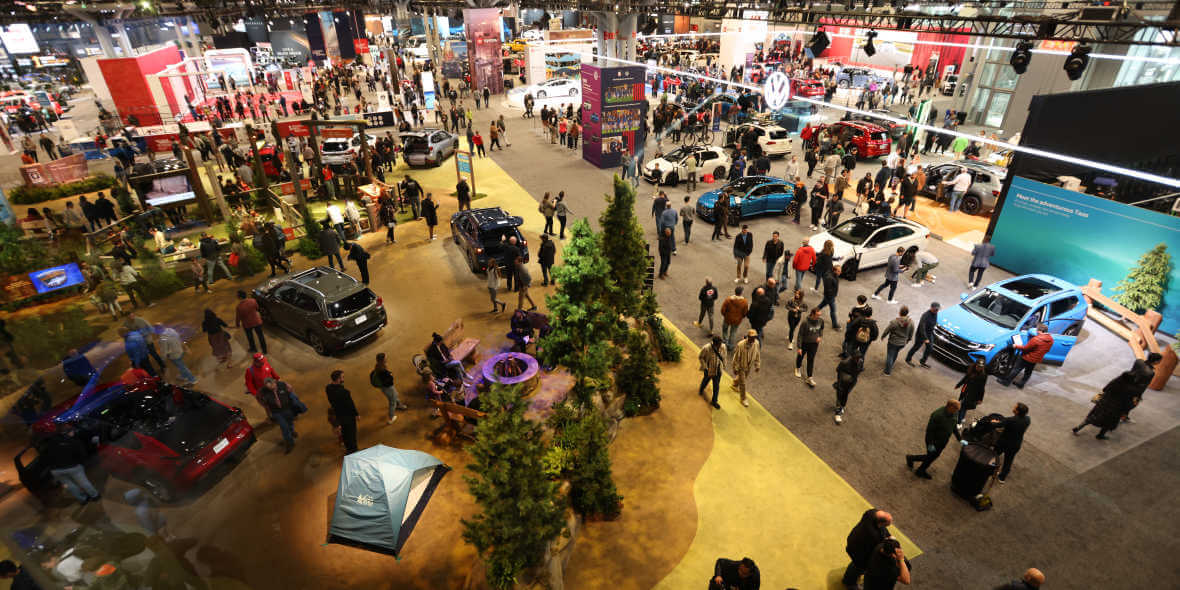
2024 New York International Motor Show (photo courtesy MTA Away)
Among U.S. auto trade shows, the 1900-present New York International Auto Show stands as the oldest and most heavily attended. Despite the obvious irony of its location in one of the only majority non-car-owner municipalities in the country, the show serves the greater northeastern auto market.
Beyond its Manhattan home, the NYIAS plays to a sector of the country that’s a major consumer of everything from sports cars to large SUVs.
And as with most of the large auto trade shows in the USA, this one is organized by a consortium of regional auto dealers.
———————————————————————————
———————————————————————————
When I first attended the NY show in ‘98, I was a 13-year-old kid in awe of the spectacle. Its sheer scale was stunning. Each of the Jacob K. Javits Convention Center’s 310,000 square meters was packed with cars, trucks, specialist manufacturers, accessory vendors, memorabilia, and eye-popping physical displays costing millions to assemble. Javits was packed to the rafters, and every company in the auto space worth mentioning knew to be there or risk looking smalltime.
On the main floor, cars ruled; the entire basement was packed with trucks and SUVs. Specialist manufacturers like Mosler, Panoz, Qvale, YES, and Saleen crowded the outskirts of the main halls.
What a difference 26 years makes. First, it’s clear that car manufacturers have discovered what watchmakers realized post-Basel; nobody needs a trade show to reach consumers. The Internet, with its dedicated news websites, social media, and manufacturer-owned platforms can reach everyone everywhere at every hour of the day.
Millions spent on sprawling booths now produce less awareness than Instagram drops, and even car purchases can be made online.
Auto manufacturers didn’t miss the cue. Notably absent at the 2024 New York show were all four of the major German luxury automakers; Audi, BMW, Mercedes-Benz, and Porsche had no official presence at the show despite dominating luxury sales in the Northeast USA.
American luxury majors Cadillac and Lincoln felt the same. Stellantis’ USA brand portfolio – Chrysler, Dodge, Fiat, Jeep, Maserati, and Ram – decided to skip the proceedings entirely.
EV leader Tesla didn’t bother to show up. Secondary halls, once flush with automotive aftermarket and lifestyle products, were sparsely filled or closed entirely. If all of this sounds grim, it’s because it is grim – at least for those who cling to nostalgia for the go-go auto shows of old.
All of that said, the evolving profiles of the cars, booths, and marketing is a topic removed from the waning scale and scope of the show. New technologies like autonomy and electric propulsion, the supplanting of cars by trucks and SUVs, and the messaging from brands drove a tonal shift from the old days.
———————————————————————————
———————————————————————————
Oddly, there was also a newfound focus on vintage and classic cars – almost as though the NYIAS were stretching to tie itself to the kind of iron that populated the floor in the show’s heyday. The surprising number of vintage models is worth exploring. This type of vehicle rarely appeared anywhere near the main floor during the show’s peak of scale and commercial relevance.
From my standpoint as an automotive fan and historian, this was one of the most appealing features of 2024’s exhibitions.

Lambo LM002
The main floor featured a showcase of vintage iron headlined by the insane 1980s Lamborghini LM002 4×4. Derived from a concept that missed a defense contract ultimately won by the vehicle we now call the Humvee, the LM002 was a military-style 4×4 powered by a Countach V12 and – appropriately – equipped if desired with a fuel tank as large as 76 gallons (287 liters).
It was popular with Middle Eastern wealth given its off-road chops and tanker-like ability to bridge the gaps in places where gas was cheap but fueling stations few and far between.
That 400hp+ V12 gave the LM002 levels of SUV performance that wouldn’t be approached again until the late 1990s, and the sound of the supercar mill in a truck was as insane as it was cognitively dissonant. The last of the line were earmarked for the U.S. market and dubbed “LM American” – that’s the model I encountered on the show floor. By today’s standards, the manual-only transmission is out of step with SUV consumer tastes, but the now-rare stick shift engagement level makes the truck even more appealing to collectors.

Porsche 356
Old-hand air cooled Porsches greeted showgoers outside the main hall courtesy of luxury specialist Manhattan Motorcars. A black 356B set the stage for an impressive procession of German iron.
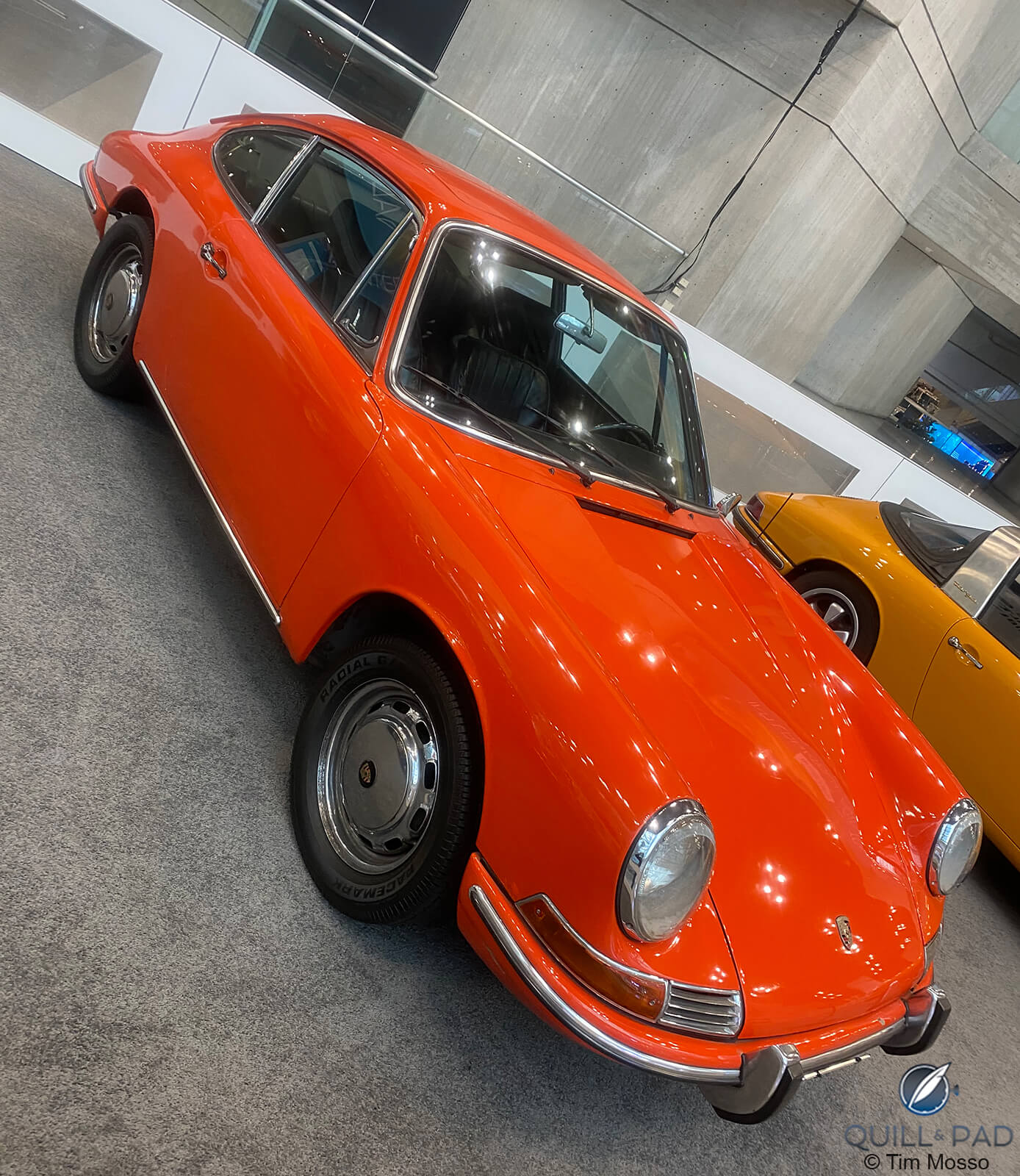
1967 Porsche 912
The 356’s successor, a 1967 model 912 – basically a four-pot 911 – added depth to the field.

1968 Porsche 911 Targa
A rare 1968 912 Targa provided an uncommon treat and more period color to the lineup.

Porsche 911 RS
Finally, the prince of them all, a lightweight 1973 Carrera RS 2.7 pegged the meter for sheer desirability and legendary reputation. There was a 918 Spyder on hand, and even the 875-horsepower supercar was upstaged by the old RS.

Porsche 918 Spider
———————————————————————————
———————————————————————————
Fans of Japanese cars and culture were thrilled to find a tastefully modified Toyota Sprinter Trueno in in a basement-level custom car corral.
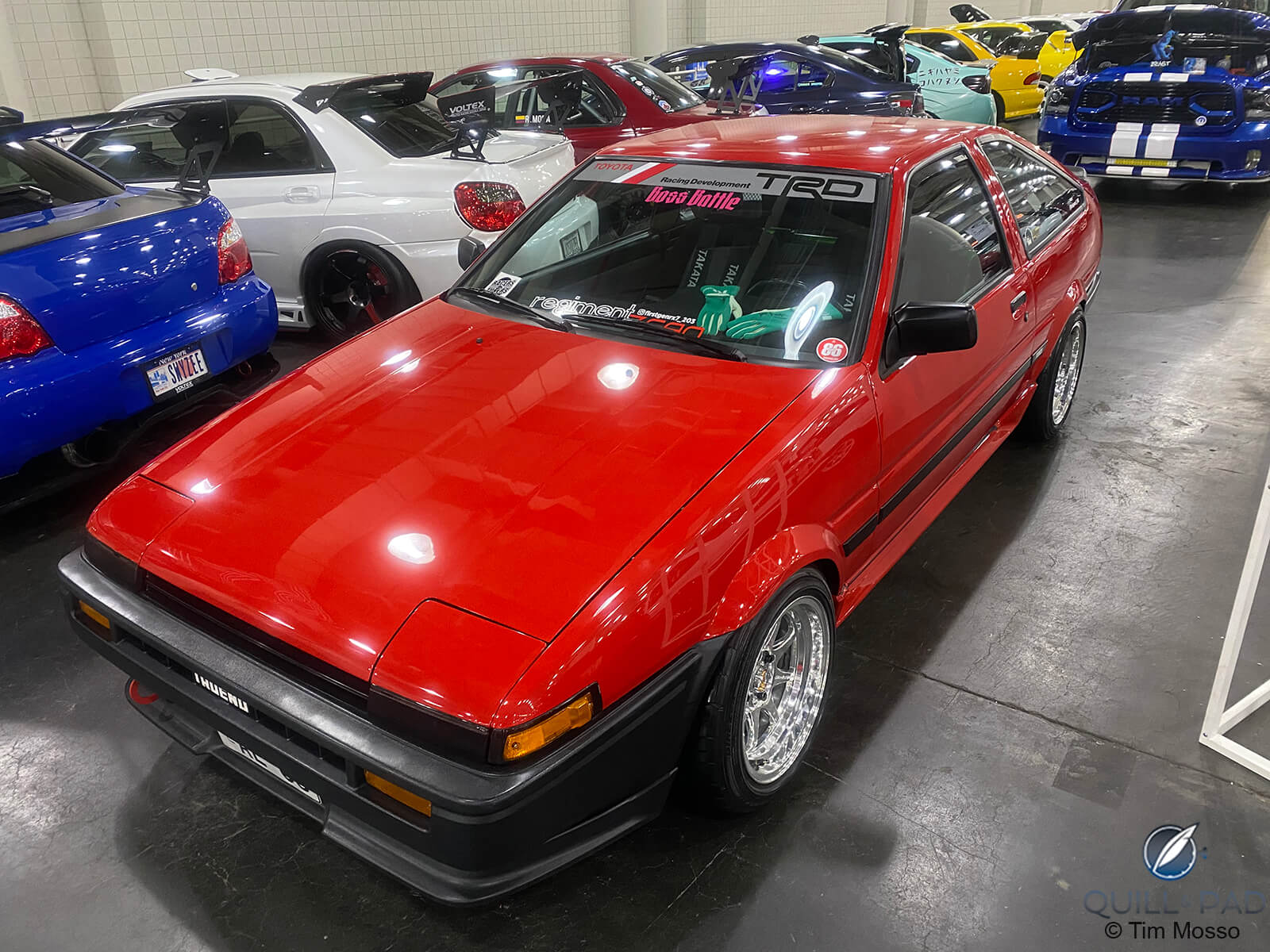
Toyota AE86
The Toyota AE86, immortalized in the manga, “Initial D,” is considered to be an early cornerstone and vanguard of the now surging U.S. collector’s market for vintage Japanese cars. This example sported a JDM license plate and “Trueno” badging for maximum emotional impact.
Volkswagen, the only German brand to have a presence at the show, continued to rehabilitate its post-emissions scandal image by prominently featuring the universally beloved Type 1 (Beetle).
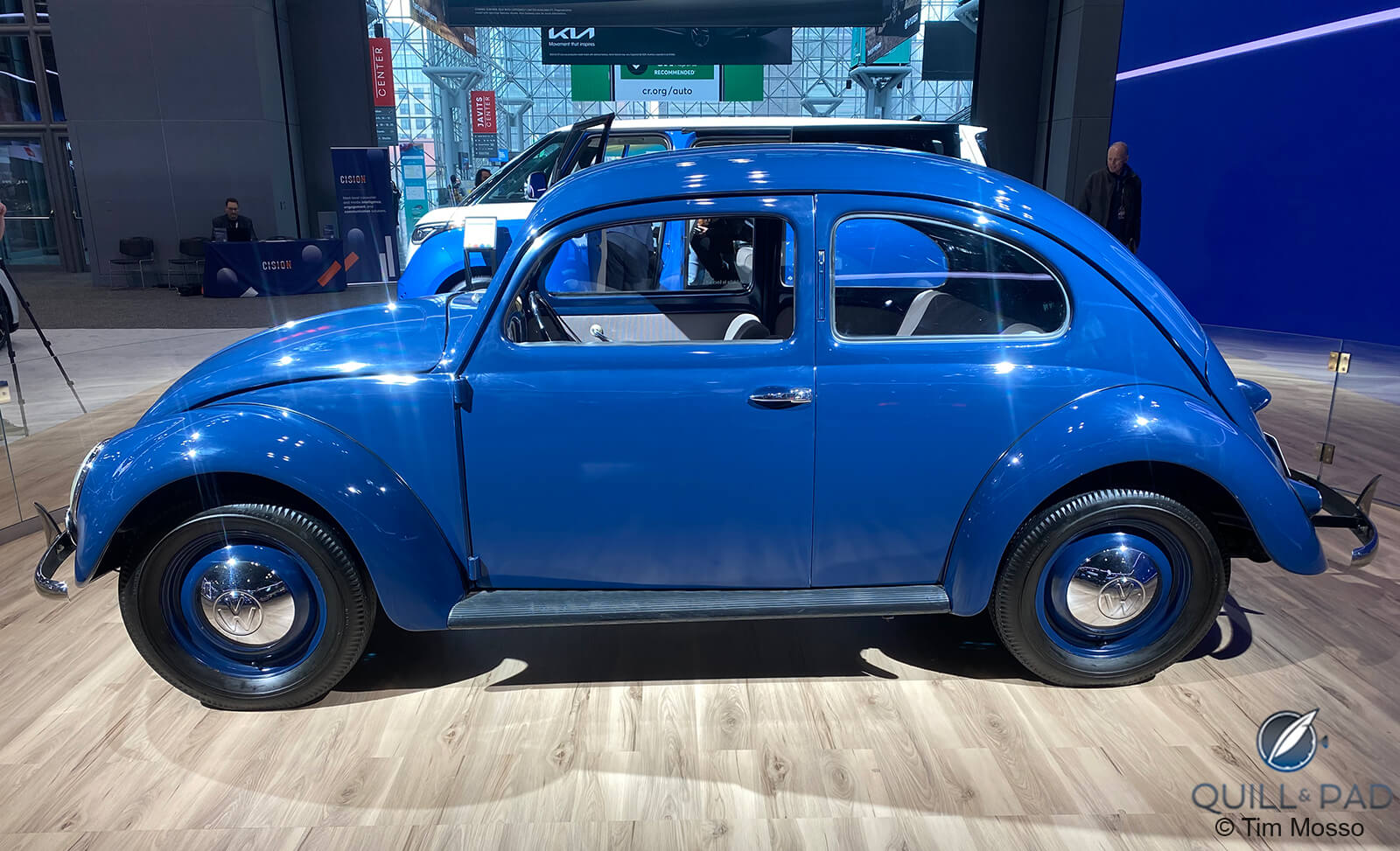
1949 VW Beetle
In this case, it was a blue 1949 example from the earliest days of the Bug in the U.S. market. 2024 marks 75 years since the USA arrival of a vehicle that became both a counter-cultural icon and the first beachhead for mass produced import cars on the American market.
Given decades of “new” Beetles, it’s easy to forget how petit and quaint an original appears in the metal. Somewhat like the original Austin Mini and Fiat 500, the sight of a vintage Bug jolts modern observers into sudden awareness of vehicle bloat. The example on display featured the hugely collectible split rear windows of the earliest U.S.-bound Beetles.
The VW booth is a good pivot point to address one of the other standout features of the NY show: electric vehicles. My 1998 foray into the NYIAS included a brush with the original American market purpose built electric car, the GM EV1.
At the time, it was an isolated thing on the show floor. Designed primarily for regulatory compliance in the California market, few EV1s were made, there was no follow-on model, and most were crushed by GM at the end of the lease-only trial period. As of 2024, a functional privately-owned EV1 is a blue-chip collectible, and EVs are approaching ten percent of the U.S. new car market.
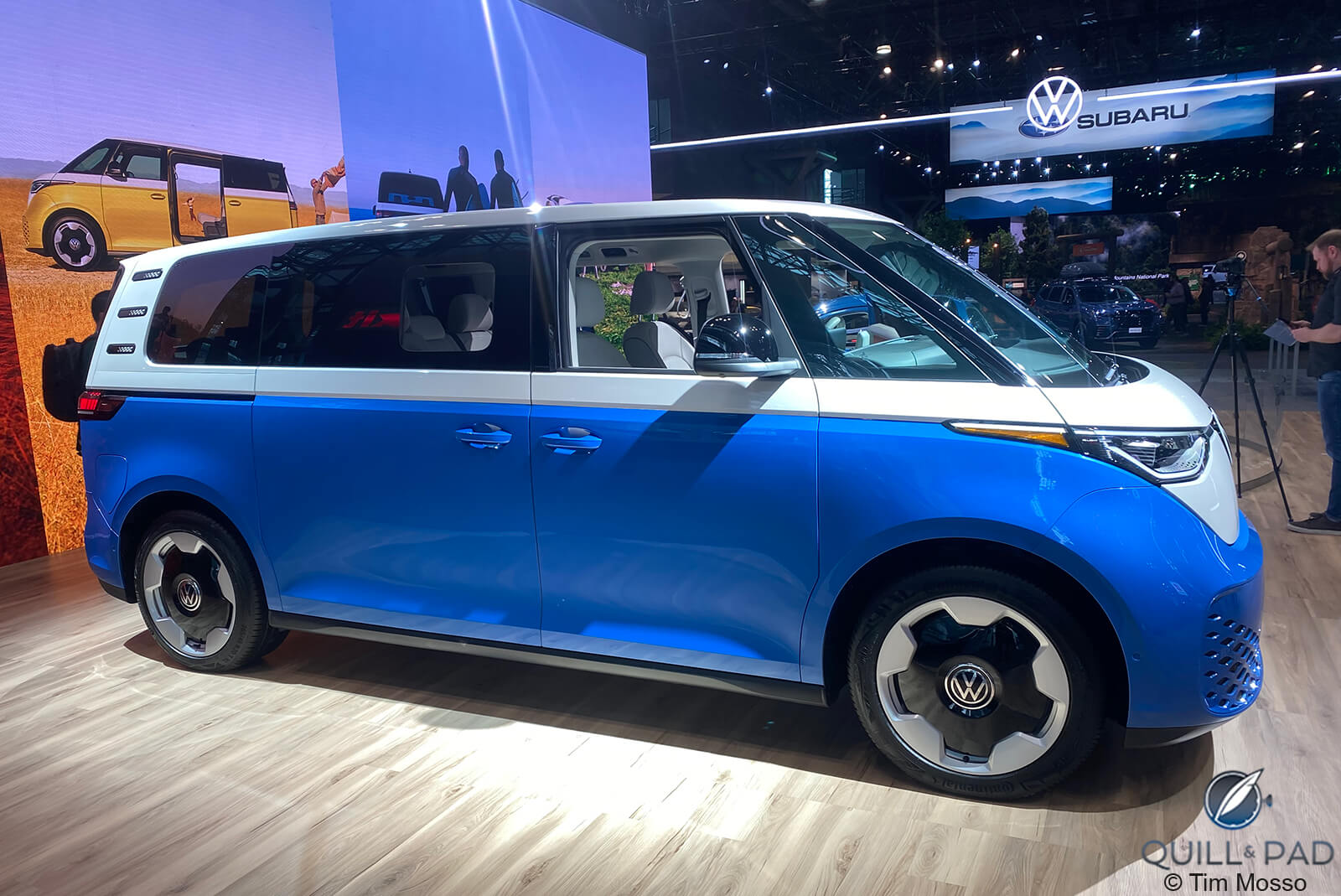
VW I.D. Buzz
Volkswagen was in on the act. While not every EV is fun or soulful, VW is betting that its reborn Bus – now the “I.D. Buzz” – can tap into nostalgia for the Woodstock-era original. The new Bus arrives in the U.S. market for 2024 as a long-wheelbase model with a 91-kW-hr battery and somewhere between 250 and 260 miles of anticipated EPA-rated range. Compared to the hose-it-out original Type 2, the “Buzz” is a luxury vehicle.
Fun details include factory two-tone paint, seating for seven, cavernous seats-out cargo space, and the obligatory giant VW logo on the nose.
———————————————————————————
———————————————————————————
Not every EV is green; some are quite mean and proud of it. The controversial GMC Hummer EV made a show appearance in both its SUT and SUV forms. Every version of this revived Hummer is crazier than any built during the brand’s original 1992-2010 run.
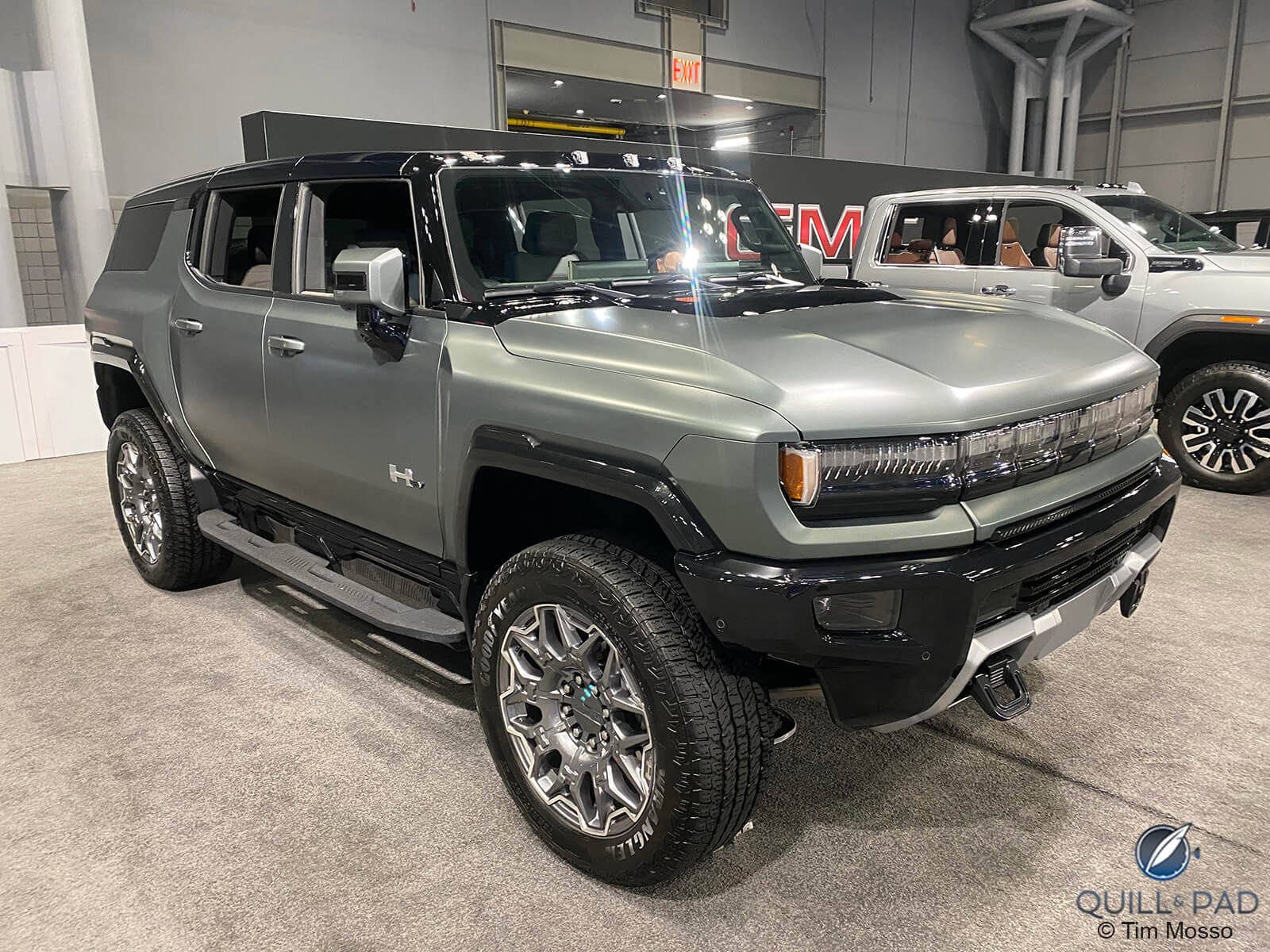
Hummer EV SUV
The Hummer Truck EV3X packs three motors, 1,000 horsepower, 3-second 0-60 acceleration potential, and a 212.7 kW-hr battery that weighs more than some compact cars at 1,278kg (2,818lbs). Tech includes four-wheel steering for a compact car turning circle, Super Cruise highway self-driving, and the ability to charge at 800 volts and 350kW.
Honestly, I kinda enjoyed the Hummer. It’s ridiculous, dangerous to everything else on the road, and a profoundly profligate use of resources. In other words, it’s a supercar that happens to be shaped like a truck – that’s how absurd its performance-to-utility ratio shakes out. In some countries, it may even require the owner to possess a special license to drive the minimally 3,929kg (8,660lb) monster.

The Hummer EV is HIGH!
I’m just not sure I could actually bring myself to buy a thing like this. You can see from my photo (above) that the end of the Hummer’s hood reaches the mid-point of my upper arm, and I’m 180cm tall. At the cowl, this hood if fully level with my shoulder.
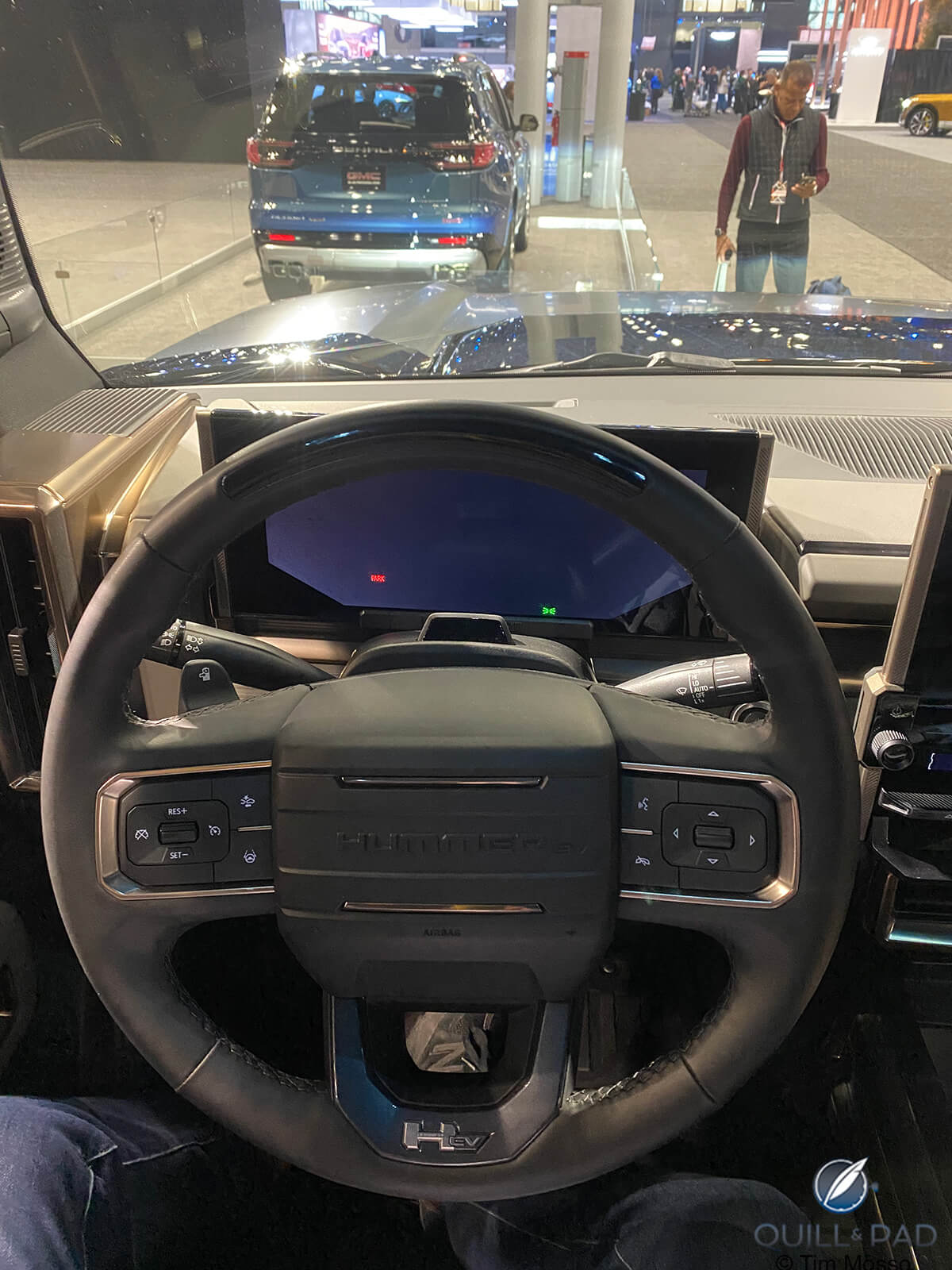
Elevated view from the driver’s seat of the Hummer EV
From the driver’s seat, the Hummer feels as towering as a bus and as unstoppable as a tank. It’s easy to imagine the driver of this thing as a real-life pilot of “The Simpsons” immortal Canyonero. That SUV got Marge shipped traffic school for road rage, so consider yourselves warned, Hummer shoppers.
Visitors to the U.S. often are surprised to learn that the most popular class of personal vehicle in the country is the full-sized half-ton pickup truck. The vast majority of these drivers are not laborers, further compounding the confusion. That said, even the pickup truck is taking a turn towards electrification.
———————————————————————————
———————————————————————————
While the newly released Tesla Cybertruck wasn’t present, GM’s Ultium-architecture EV pickups seemed to be everywhere. The Silverado EV was on hand in its flagship RST form. Based on most of the same hardware as the Hummer EV, the Silverado is comparably hulking and massive.
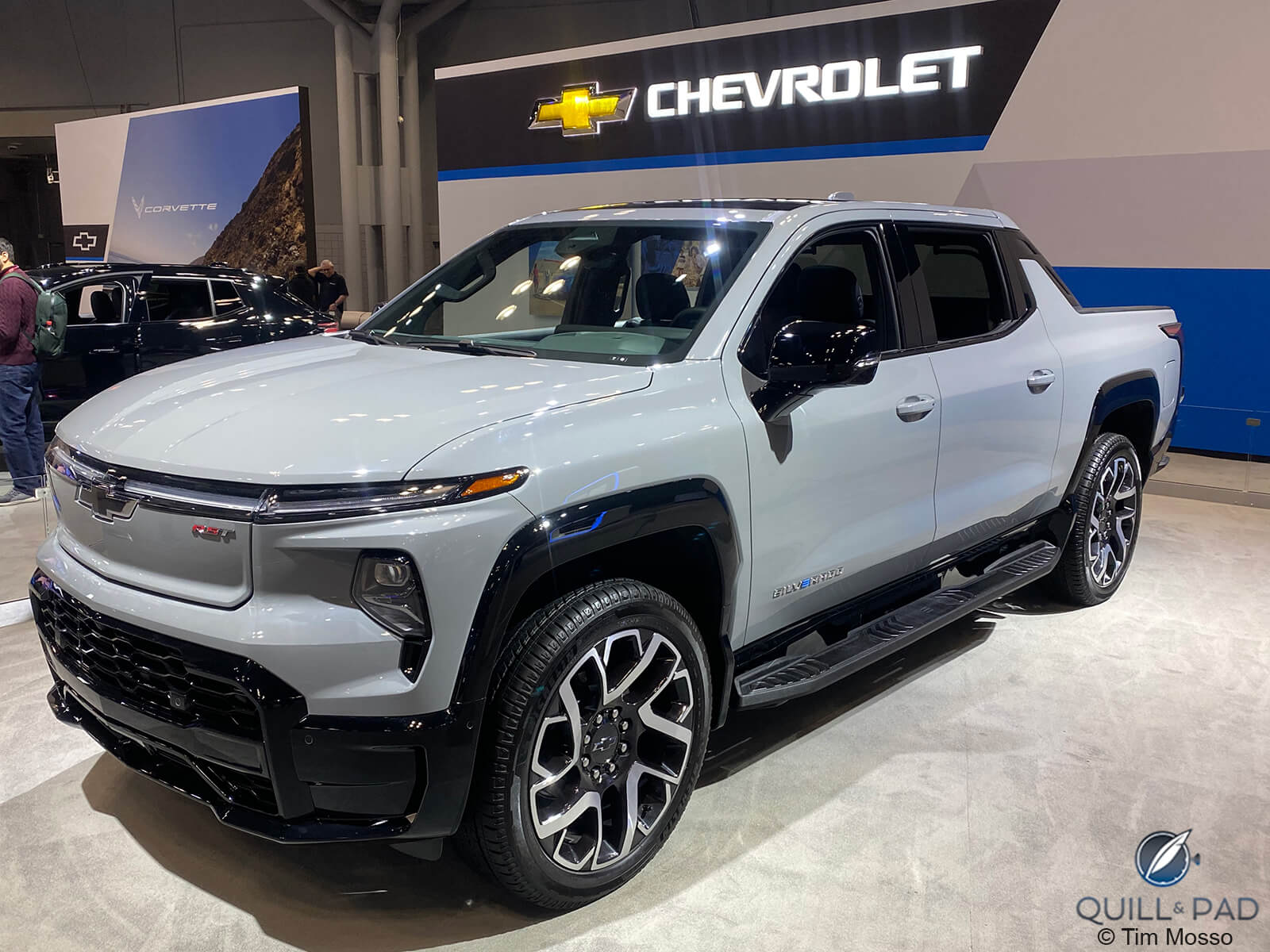
Silverado EV
With 750hp+, this is yet another EV aimed to convert gasoline and truck-culture holdouts who still view EVs through a political filter.
While the roughly $96,000 retail price is steep, this kind of sticker is surprisingly common in the internal combustion truck market – especially when luxury trims are bought primarily for non-commercial use.
The Silverado EV included elements both frivolous and practical. The “Multi-Flex Midgate” pass-through allows the owner to extend the bed into the passenger cabin while carrying long objects. And the protectively pre-lined truck bed includes tie-downs, rails, and power take-offs to operate electrical accessories.
Super Cruise autonomy is featured as is the four-wheel steering from the Hummer. Chevy is talking a big game with a 708km (440mi) range rating on the RST, so this is – for now – the EV truck range leader.
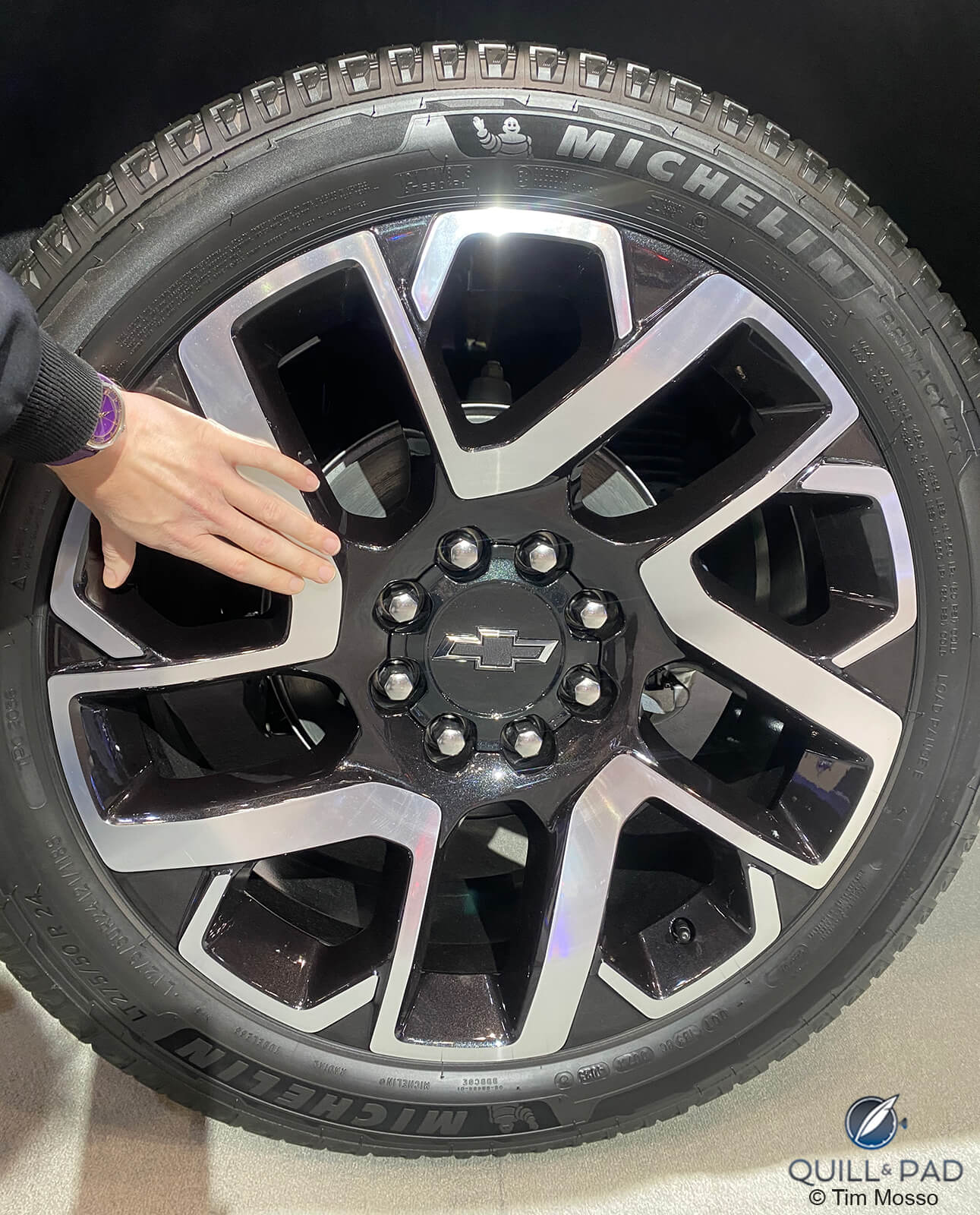
Massive 24″ Silverado EV wheel
And check out those 24” wheels on the RST… my hand looks like a postage stamp in comparison. Interior trim is high-luxe complete with premier materials and contrasting stitching. Also, just because a $96,000 pickup isn’t unusual in the USA doesn’t mean it makes any sense. But if sense is what you want in a pickup truck, then Chevrolet has a Colorado with your name on it.

Mustang Mach-E
Smaller – though not small – budgets might consider a different kind of prestige EV. The Ford Mustang Mach-E is controversial for co-opting the Mustang name to sell an EV SUV. That said, its performance potential places it on a plane beyond most conventional Mustangs ever built. Let’s face it; there’s been a lot of Florida rental ‘stangs with auto boxes and 4-6 cylinders.
There were the Mustang IIs. And even the beloved first generation spawned a bunch of limp straight sixes that get instantly swapped for Coyote V8s when the survivors are restomodded. The Mach-E hits 60mph in 3.3 seconds and runs the quarter in 11.8. That’s real Mustang pace.
The most interesting Mach-E variant, the 2024 “Rally,” is both a tribute to Ford’s decades of competition in World Rally Championship and a spiritual successor to the late, great, Focus RS. The Rally certainly looks the part with WRC-inspired white wheels with loose-surface rubber. Extra ground clearance (20mm) and underbody armor join the party below the water line.
Larger brake rotors are included, springs are upgraded, there’s an off-road traction mode for the dirt, a recovery hook not featured on the standard Mach-E, and special fog lights mounted high. While more has been hinted by the time of release, the Rally boasts at least 480 horsepower and 700lb-ft channeled through four wheels, so this is a genuine performance vehicle.
Naturally, there were racing stripes and a rear wing for fashion’s sake.
———————————————————————————
———————————————————————————
Extreme niche luxury EVs seemed to be everywhere. A regional dealer brought out an example of the new Rolls-Royce Spectre EV coupe. At 577hp and 266 miles/428 kms of rated range, this is a capable vehicle, but it isn’t a “numbers” car on a performance or range basis.

Rolls Royce Spectre EV
Of all the ultra-luxury and extreme performance EV options at the show, the Rolls-Royce driving experience seems the most natural one to adopt the lugubrious qualities of a silent and torquey powertrain. It’s not a supercar in the performance sense; it’s an isolation chamber for total immersive serenity.
The bespoke Spectre featured at the show matched my purple Sartory Billard SB04 to perfection, but the car is customizable to an absurd degree, so don’t get hung up on the color. With a base price of $422,750 and no realistic upper limit beyond that, this is a car destined to sell to the rare plutocrat dandy who also desires an EV.
But even Rolls-Royce is mainstream compared to Karma. Risen from the ashes of the original Fisker Automotive,

Karma Gyesera EV
Karma is a U.S.-based and Chinese-owned EV luxury car builder out of Southern California. Its four-door Gyesera is visibly – and mechanically – descended from the original hybrid Fisker Karma, but the Gyesera is a full EV. The 570hp/250-mile headline numbers break no new ground, but, like the Spectre, this isn’t a numbers car; Gyesera sells on style.
While the Gyesera is destined for imminent production, the Kaveya coupe is more of a concept car. Although Karma insists it is a production-intent vehicle, Karma’s past product projections have been as reliable as a Ouija board. If it were to see production, the wild machine would boast 1,000 horsepower, 0-60 times below three seconds, and style to make Aston Martin buyers think twice.
The Kaveya has a link to the watch world; Michelle Christensen VP, Global Design for Karma, oversaw the EV super coupe’s creation. Christensen is the wife of Devon Tread designer and Wilbur Watch Co. founder Jason Wilbur. Previously, Christensen was credited as primary designer of the second-generation Acura NSX, and she met Jason when the two of them were assigned to Honda’s U.S. design office.
———————————————————————————
———————————————————————————
Among the supercar auteurs in the world today, the name Mate Rimac doesn’t – yet – command the same recognition as Christian von Koenigsegg or Horacio Pagani, but the 36-year-old Croatian deserves that respect and more. His Rimac Group counts Porsche as a major investor, comprises the eponymous Rimac Automobili sports car brand, and includes Bugatti. Yes, he oversees that Bugatti. But the core Rimac product is the Nevera ultracar.

Rimac
Truthfully, “ultracar” is warranted because “supercar” no longer suffices for a vehicle with four electric motors and 1,888hp. This is nothing like the 400hp+ “supercars” of the 1980s or even the 700-1,000hp turbo and hybrid machines of recent years. With a 0-60 time of 1.74 seconds, the Nevera clearly is quick, but various EV sedans can come close to that today.
No, that’s not the measure of its speed…
…the most revealing Nevera acceleration time is this: less than 30 seconds to… 249mph/400kph! That’s only seven mph below the car’s actual top speed. It runs quarter miles in the 8-second range and stops the clock at 7:05 around the Nürburgring Nordschleife – where other EVs tend to cook themselves and thermal before the lap even ends. 150 Neveras are slated for production for around $2.2 million apiece.
———————————————————————-
———————————————————————————
An indoor EV test track marked the declining show’s single greatest change for the better – ripping around an indoor track is fun. While it was impossible to drive oneself in the cars, trained employees piloting an array of EV performance models provided entertaining joy rides.
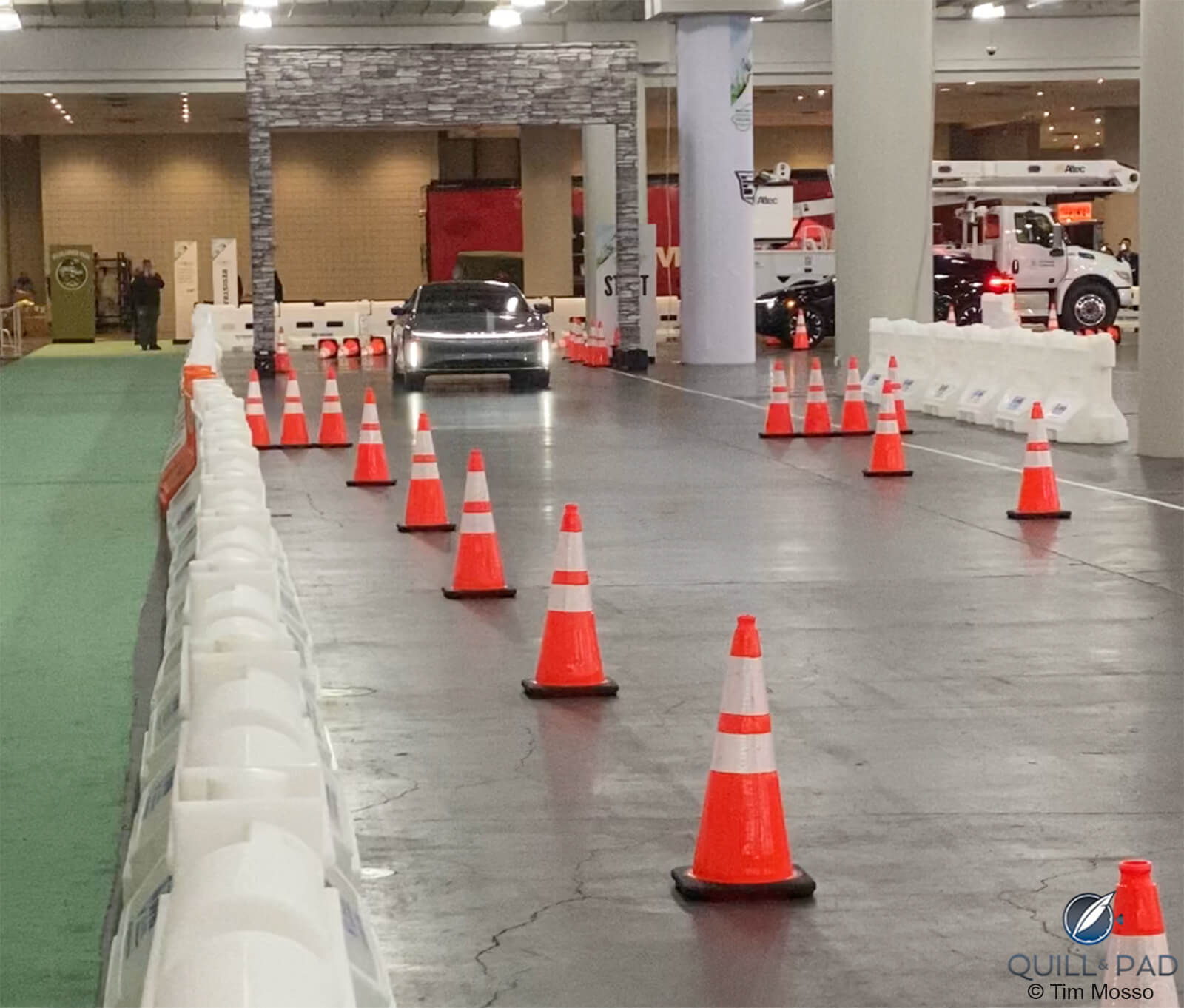
EV Test Track
Due to the total lack of emissions, the EVs can run indoors all day long, and their eerily quiet accelerator dumps portend the future of automotive performance. It takes some getting used to, but the sensations inside the vehicles are stunning.
While the automotive action was on the test track, the hit of the show was the only vehicle – EV or otherwise – that I was allowed to drive firsthand. Actually, make that “ride” firsthand. Newly launched by Honda’s U.S. arm, the Motocompacto is a crazy electric pizza box that you can ride on public roads.
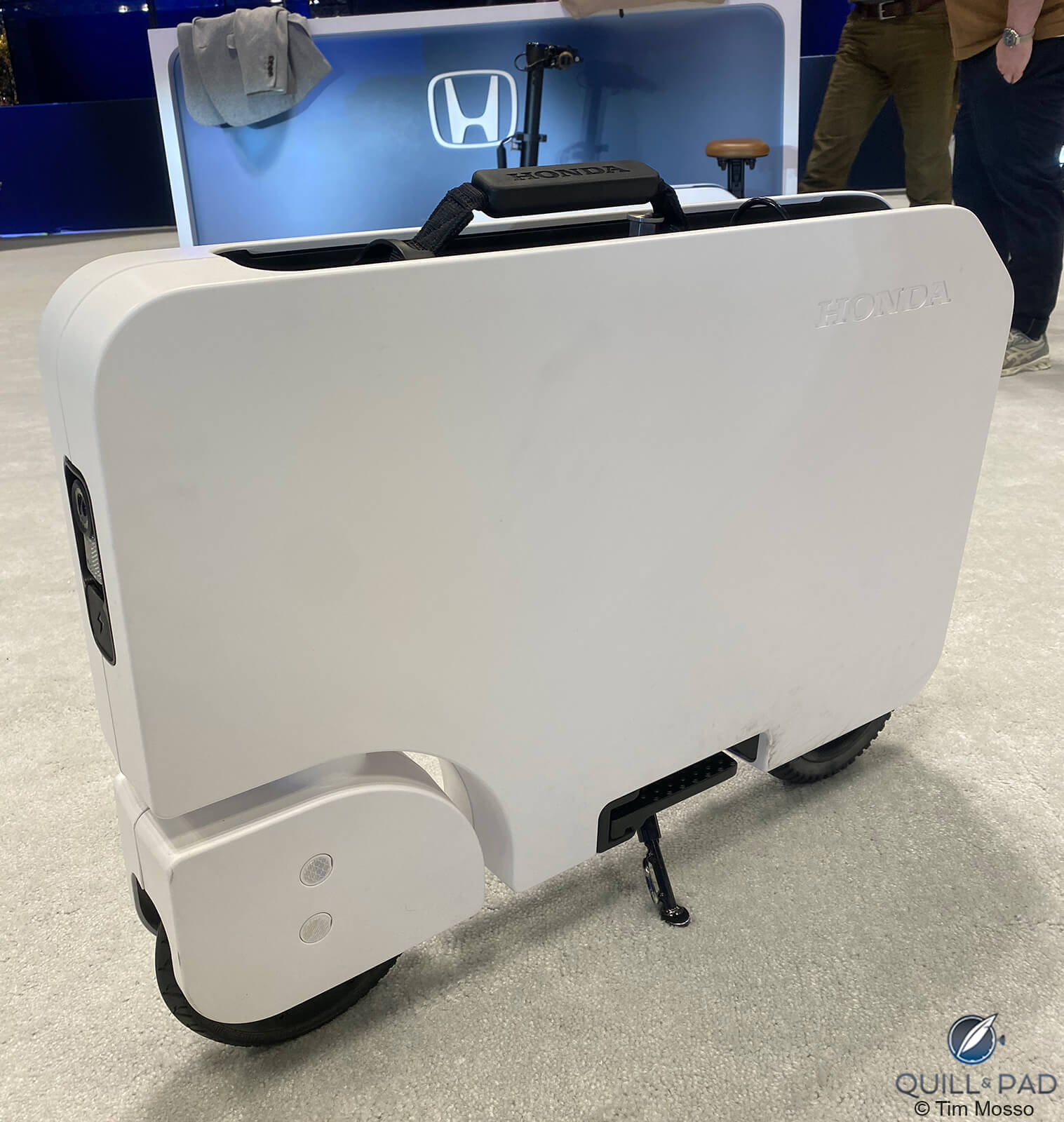
(Very large) briefcase sized Motocompacto
The EV scooter, which is inspired by the two-stroke 1980s “Motocompo,” is an 18.6kg (41lb) collapsible “last mile” solution developed with commuters in mind.

Tim Mosso on the Motocompacto
Each Motocompacto is designed to be stowed until needed on a car ride or commuter train. It has a fold-out handle and an aluminum frame to make it more portable. When deployed, the scooter sports a small seat, a tiny handlebar and steering column, and a fold-out rear wheel.
There’s a kickstand. The handlebar includes an accelerator button, lever-actuated front brake, a tiny bell for signaling your presence, and control over the integrated front and rear lights. Sadly, for friends in Europe and Asia who might get the most use from this concept, it’s a U.S. exclusive for now.
Mechanically, the Motocompacto packs a battery good for 12 miles under an assumed 99.7kg (220lb) rider. Lighter riders will get more range; a 120.2kg (265lb) rider is the limit. The front wheel drives the little scooter, and its maximum of 15mph feels absolutely wild given the miniscule size of the thing under your body at that speed. There are plenty of places in Manhattan where even taxis don’t hit 15mph, and the assembled NYC residents seemed impressed.
Recharging takes place from a wall socket in 3.5 hours, so, in theory, you could use it on a 20-mile round-trip commute with a bit of buffer left over. Truthfully, even Honda doesn’t entertain such long-haul flights of fancy. It describes the Motocompacto as a subway-to-office solution or something to deploy from the SUV after parking in a city.
Honda’s done its research, and it believes the combination of signaling features plus the 15mph speed limit should keep the Motocompacto legal in most parts of the USA. Despite the raft of dream cars present on the show floor, journalists attending the show near-universally declared the Motocompacto test ride to be the most fun they had at the event. And for a Honda-recommended retail price of $990, almost anyone can share that feeling.
The second and final installment of this NYIAS survey will deal with the most popular class of vehicle to most gearheads and showgoers: traditional internal combustion performance.
For more information, please visit www.autoshowny.com
Your might also enjoy:
Collecting Watches And Cars: What’s The Same And What’s Different?
Porsche 911 Carrera 4S (992): A Twin-Turbo-Powered Evolution
Leave a Reply
Want to join the discussion?Feel free to contribute!



Tim,
Cars aside, love your Satory- Billard.
Cheers!